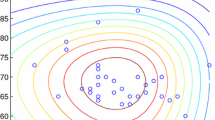Abstract
Recently the proportional reversed hazard model has received a considerable amount of attention in the statistical literature. The main aim of this paper is to introduce a bivariate proportional reversed hazard model and discuss its different properties. In most of the cases the joint probability distribution function can be expressed in compact forms. The maximum likelihood estimators cannot be expressed in explicit forms in most of the cases. EM algorithm has been proposed to compute the maximum likelihood estimators of the unknown parameters. For illustrative purposes two data sets have been analyzed and the performances are quite satisfactory.

Similar content being viewed by others
References
Aarset, M.V. 1987. How to identify a bathtub hazard rate? IEEE Transactions on Reliability 36:106–108.
Bemis, B., Bain, L.J., and Higgins, J.J. 1972. Estimation and hypothesis testing for the parameters of a bivariate exponential distribution. Journal of the American Statistical Association 67:927–929.
Block, H.W., Savits, T.H., and Singh, H. 1998. On the reversed hazard rate function. Probability in the Engineering and Informational Sciences 12:69–90.
Chandra, N.N., and Roy, D. 2001. Some results on reversed hazard rate. Probability in the Engineering and Informational Sciences 15:95–102.
Crescenzo, A.D. 2000. Some results on the proportional reversed hazard model. Statistics and Probability Letters 50:313–321.
Csorgo, S., and Welsh, A.H. 1989. Testing for exponential and Marshall–Olkin distribution. Journal of Statistical Planning and Inference 23:287–300.
Dinse, G.E. 1982. Non-parametric estimation of partially incomplete time and types of failure data. Biometrics 38:417–431.
Gupta, R.D., and Kundu, D. 1999. Generalized exponential distribution. Australian and New Zealand Journal of Statistics 41:173–188.
Gupta, R.D., and Nanda, A.K. 2001. Some results on (reversed) hazard rate ordering. Communications in Statistics—Theory and Methods 30:2447–2458.
Gupta, R.D., and Kundu, D. 2007. Generalized exponential distribution: Existing methods and recent developments. Journal of Statistical Planning and Inference 137:3537–3547.
Gupta, R.C., and Gupta, R.D. 2007. Proportional reversed hazard rate model and its applications. Journal of Statistical Planning and Inference 137:3525–3536.
Gupta, R.D., Gupta, R.C., and Sankaran, P.G. 2004. Some characterization results based on the (reversed) hazard rate function. Communications in Statistics—Theory and Methods 33:3009–3031.
Gupta, R.C., Gupta, P.L., and Gupta, R.D. 1998. Modeling failure time data by Lehmann alternatives. Communications in Statistics—Theory and Methods 27:887—904.
Ibragimov, I.A. 1956. On the composition unimodal distribution. Theory of Probability and its Applications 1:255–260.
Kundu, D., and Dey, A.K. 2009. Estimating the parameters of the Marshall Olkin bivariate Weibull distribution by EM algorithm. Computational Statistics and Data Analysis 53:956–965.
Kundu, D., and Gupta, R.D. 2009. Bivariate generalized exponential distribution. Journal of Multivariate Analysis 100:581–593.
Kundu, D., and Raqab, M.Z. 2005. Generalized Rayleigh distribution: Different methods of estimation. Computational Statistics and Data Analysis 49:187–200.
Lehmann, E.L. 1953. The power of rank test. Annals of Mathematical Statistics 24:23–42.
Louis, T.A. 1982. Finding the observed information matrix when using the EM algorithm. Journal of the Royal Statistical Society, Series B 44:226–233.
Marshall, A.W., and Olkin, I. 1967. A multivariate exponential distribution. Journal of the American Statistical Association 62:30–44.
Meintanis, S.G. 2007. Test of fit for Marshall–Olkin distributions with applications. Journal of Statistical Planning and Inference 137:3954–3963.
Mudholkar, G.S., and Srivastava, D.K. 1993. Exponentiated Weibull family for analyzing bathtub failure data. IEEE Transactions on Reliability 42:299–302.
Mudholkar, G.S., Srivastava, D.K., and Freimer, M. 1995. The exponentiated Weibull family: A reanalysis of the bus-motor-failure data. Technometrics 37:436–445.
Nanda, A.K., and Gupta, R.D. 2001. Some properties of reversed hazard function. Statistical Methods, 3:108–124.
Sarhan, A., and Balakrishnan, N. 2007. A new class of bivariate distribution and its mixture. Journal of Multivariate Analysis 98:1508–1527.
Sarhan, A., and Kundu, D. 2009. Generalized linear failure rate distribution. Communications in Statistics—Theory and Methods 38:642–660.
Shawky, A.I., and Abu-Zinadah, H.H. 2008. Characterizations of the exponentiated Pareto distribution based on record values. Applied Mathematical Sciences 2:1283–1290.
Surles, J.G., and Padgett, W.J. 1998. Inference for P(Y < X) in the Burr Type X model. Journal of Applied Statistical Science 7:225–238.
Surles, J.G., and Padgett, W.J. 2001. Inference for reliability and stress-strength for a scaled Burr Type X distribution. Lifetime Data Analysis 7:187–200.
Surles, J.G., and Padgett, W.J. 2005. Some properties of a scaled Burr type X distribution. Journal of Statistical Planning and Inference 128:271–280.
Tsodikov, A.D., Aselain, B., and Yakovlev, A.Y. 1997. A distribution of tumor size at detection: An application to breast cancer data. Biometrics 53:1495–1502.
Acknowledgements
The authors would like to thank the referee and the editor Professor Ayanendranath Basu for their valuable comments.
Author information
Authors and Affiliations
Corresponding author
Additional information
Part of Debasis Kundu’s work has been supported by a grant from the Department of Science and Technology, Government of India.
Part of Rameshwar D. Gupta’s work has been supported by a discovery grant from NSERC, Canada.
Rights and permissions
About this article
Cite this article
Kundu, D., Gupta, R.D. A class of bivariate models with proportional reversed hazard marginals. Sankhya B 72, 236–253 (2010). https://doi.org/10.1007/s13571-011-0012-1
Received:
Revised:
Accepted:
Published:
Issue Date:
DOI: https://doi.org/10.1007/s13571-011-0012-1



